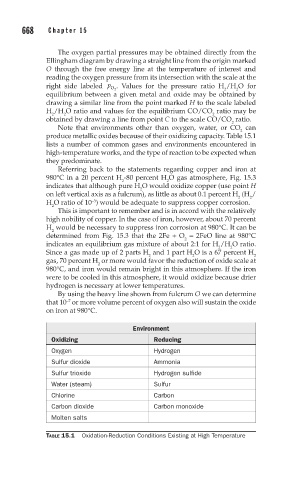Page 714 - Corrosion Engineering Principles and Practice
P. 714
668 C h a p t e r 1 5 H i g h - Te m p e r a t u r e C o r r o s i o n 669
The oxygen partial pressures may be obtained directly from the
Ellingham diagram by drawing a straight line from the origin marked
O through the free energy line at the temperature of interest and
reading the oxygen pressure from its intersection with the scale at the
right side labeled p . Values for the pressure ratio H /H O for
O 2 2 2
equilibrium between a given metal and oxide may be obtained by
drawing a similar line from the point marked H to the scale labeled
H /H O ratio and values for the equilibrium CO/CO ratio may be
2
2
2
obtained by drawing a line from point C to the scale CO/CO ratio.
2
Note that environments other than oxygen, water, or CO can
2
produce metallic oxides because of their oxidizing capacity. Table 15.1
lists a number of common gases and environments encountered in
high-temperature works, and the type of reaction to be expected when
they predominate.
Referring back to the statements regarding copper and iron at
980°C in a 20 percent H -80 percent H O gas atmosphere, Fig. 15.3
2
2
indicates that although pure H O would oxidize copper (use point H
2
on left vertical axis as a fulcrum), as little as about 0.1 percent H (H /
2
2
H O ratio of 10 ) would be adequate to suppress copper corrosion.
–3
2
This is important to remember and is in accord with the relatively
high nobility of copper. In the case of iron, however, about 70 percent
H would be necessary to suppress iron corrosion at 980°C. It can be
2
determined from Fig. 15.3 that the 2Fe + O = 2FeO line at 980°C
2
indicates an equilibrium gas mixture of about 2:1 for H /H O ratio.
2
2
Since a gas made up of 2 parts H and 1 part H O is a 67 percent H
2
2
2
gas, 70 percent H or more would favor the reduction of oxide scale at
2
980°C, and iron would remain bright in this atmosphere. If the iron
were to be cooled in this atmosphere, it would oxidize because drier
hydrogen is necessary at lower temperatures.
By using the heavy line shown from fulcrum O we can determine
that 10 or more volume percent of oxygen also will sustain the oxide
–7
on iron at 980°C.
Environment
Oxidizing Reducing
Oxygen Hydrogen
Sulfur dioxide Ammonia
Sulfur trioxide Hydrogen sulfide
Water (steam) Sulfur
Chlorine Carbon
Carbon dioxide Carbon monoxide
Molten salts
TABLE 15.1 Oxidation-Reduction Conditions Existing at High Temperature

